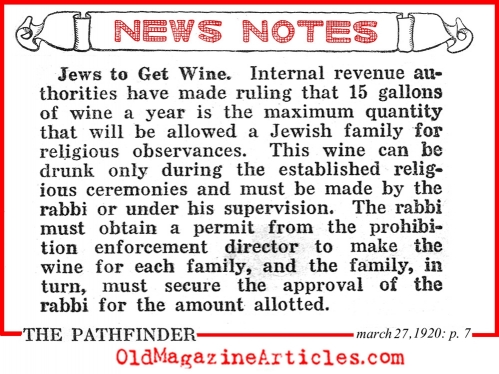Religious liberty and American prohibition:

The war clouds may have been gathering over Europe in 1933, but in British Palestine the skies were blue and life was good. Just as this 1922 magazine article intimated eleven years earlier, British Palestine was continuing to flourish in ways that neither the resident Zionists or the overseers from the British Colonial Office ever anticipated:
"Two years ago, [British] Palestine's orange crop - its main source of income - filled 2,000,000 cases at most. The forecast for the coming year is 6,000,000. Tel Aviv, a Jewish settlement near Jaffa, had 2,000 inhabitants in 1919. Now it claims 60,000 with 100,000 close ahead..."
"I have always said that there are no good Jews, but that boy proved me wrong."
-so spake the Nazi king-pin Julius Streicher (1885 – 1946) upon being confronted by the goodness of one American serviceman who went out of his way to be kind and identified himself as a Jew. This small piece is an excerpt from a longer article; to read the entire magazine article, click here.
Julius Streicher had an IQ that measured 106 - click here to read about the IQs of the other lunatics in Nazi leadership...
Click here to read about the inmate rebellions that took place at Auschwitz, Sobibor and Triblinka.
"From a guarded high-walled villa in Alexandria, Mohammad Amin al-Husayni (1895 - 1974), exiled fifty-three year-old Grand son of the Grand Mufti of Jerusalem craftily directs the affairs of the 1,200,000 Palestinian Arabs." "In the Mufti's web, the strands of potential organized resistance include two rival 'youth organizations', the al-Najjada and the Al-Futawa and the 'mobile elements' of the secret Muslim Brotherhood, which is a sort of Middle Eastern Ku Klux Klan. The precise figures of their strength are elusive, but combined they may comprise something like 50,000 men and boys." "Mohammad Nimr al-Hawari, thirty-eight-year-old leader of the Najjada told me, 'We believe in force'." After reading this article I thought about how deeply Rudolf Israel Kasztner (1906 - 1957) probably longed for a quiet life as an anonymous journalist in his native Bucharest, but the Nazi invasion of Hungary put an end to any possibility of enjoying such a life. Recognizing what the occupying Nazis had in store for the Jews of Bucharest, Kasztner saw that there was no one about who was making any attempt to save them. Rather than close his eyes and hope for the best, Kasztner bravely made the decision to save as many Jews as he could by making deals with the horrible Adolf Eichman. Locating allies at home and abroad, Kasztner managed to save thousands while others died. Today, the descendants of the Jews he had saved number in the hundreds of thousands, but this meant little to the 15 year-old Israeli fanatic who labeled him a collaborator and shot him in 1957.
Having suffered from a Jewish-lead boycott of German goods that had been in place for two years, the businessmen of Nazi Germany dispatched Dr. Julius Lippert (1895 – 1956) off to Washington in order soothe hurt feelings and bring an end to it all. Seeing that Lippert was a devoted anti-Semite and the whole dust-up commenced because of the widespread anti-Semitic sensations that made up the very core of Hitler's Germany were still in place and not likely to subside any time soon, Washington functionaries probably yawned and informed him that there was nothing that could be done on the Federal level.
"The old-style pogroms which made the life of Polish Jews a nightmare under the Czars have died out, yet the terror of Antisemitism still haunts their three million men, women and children, one-tenth of the country's population." "Now they are a race apart, isolated, according to Sholem Asch (1880- 1957), a Yiddish writer who recently visited the country, like lepers. Young women in the Warsaw Ghetto look like dried skeletons, he says. Rickety children save scraps of bread from their free school lunches to feed their parents at night." |
MORE ARTICLES >>> PAGE: * 1 * 2 * 3 * 4 * 5 * 6 * 7 * > NEXT |
|